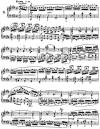Romantic Music:
“Classicism [or Enlightenment/Age
of Reason] is conservatism in creativity with emphasis on balance, control,
proportion, symmetry and restraint. Romanticism is a more radical kind of
expression, it seeks out the new, the curious, and the adventurous. It is
characterized by restless seeking and impulsive reaction. Romantic art differs
from classic art by its greater emphasis on the qualities of remoteness and
strangeness. A fundamental trait of Romanticism is boundlessness. Throughout
the Romantic period, the human mind was peculiarly attracted by
disproportionate and excessive features. The tiny piano piece and the brief
lyrical song, forms which had been of no consequence during the Classical
period, now assumed the highest significance. On the other hand, the moderate
length of the classical symphony and opera was hugely extended (Mahler's
symphonies, Wagner's operas). As against the classic ideals of order,
equilibrium, control, and perfection within acknowledged limits, Romanticism
cherishes freedom of expression, movement, passion, and endless pursuit of the
unattainable (fantasy and imagination); a search for new subject matters.
Because its goal can never be attained, romantic art is haunted by a spirit of
longing. The creations of the romantic artist were emotional in character
rather than guided by structural rules.
The Romantic movement in music
coincides with a general Romantic movement in all arts. At this period,
the arts of literature and painting began to influence music. In the Romantic
era, music acquired poetic or philosophical meaning. Antiquity, folklore,
history and exotic cultures were examined as possible sources of inspiration.
Romanticism in literature appears to precede the first signs of Romantic music
(for example Goethe [1749-1832] and Wordsworth [1770-1850]). The romantic
movement was fostered especially by a number of German writers and poets.
Their influence on musicians was pervasive and enduring. …
… The Romantic era was the
golden age of the virtuoso. The emotional range of music was
considerably widened, as was its harmonic vocabulary and the range and
number of instruments. The most characteristic orchestral form is the
symphonic poem in which the music tells a story or parallels its emotions.
The most characteristic new genre is the solo song with piano accompaniment
(Schubert, Schumann, Brahms, Wolf).
… Free modulation into distant
keys without pivot chords became a common practice. The increasing
boldness of composers in modulating to ever more distant keys, and in
coloring, or altering the notes of their chords more and more together
with the less frequent use of perfect cadences, the strength of a single
tonal center became diluted and tonality started to disintegrate.”
(http://dorakmt.tripod.com/music/romantic.html)


